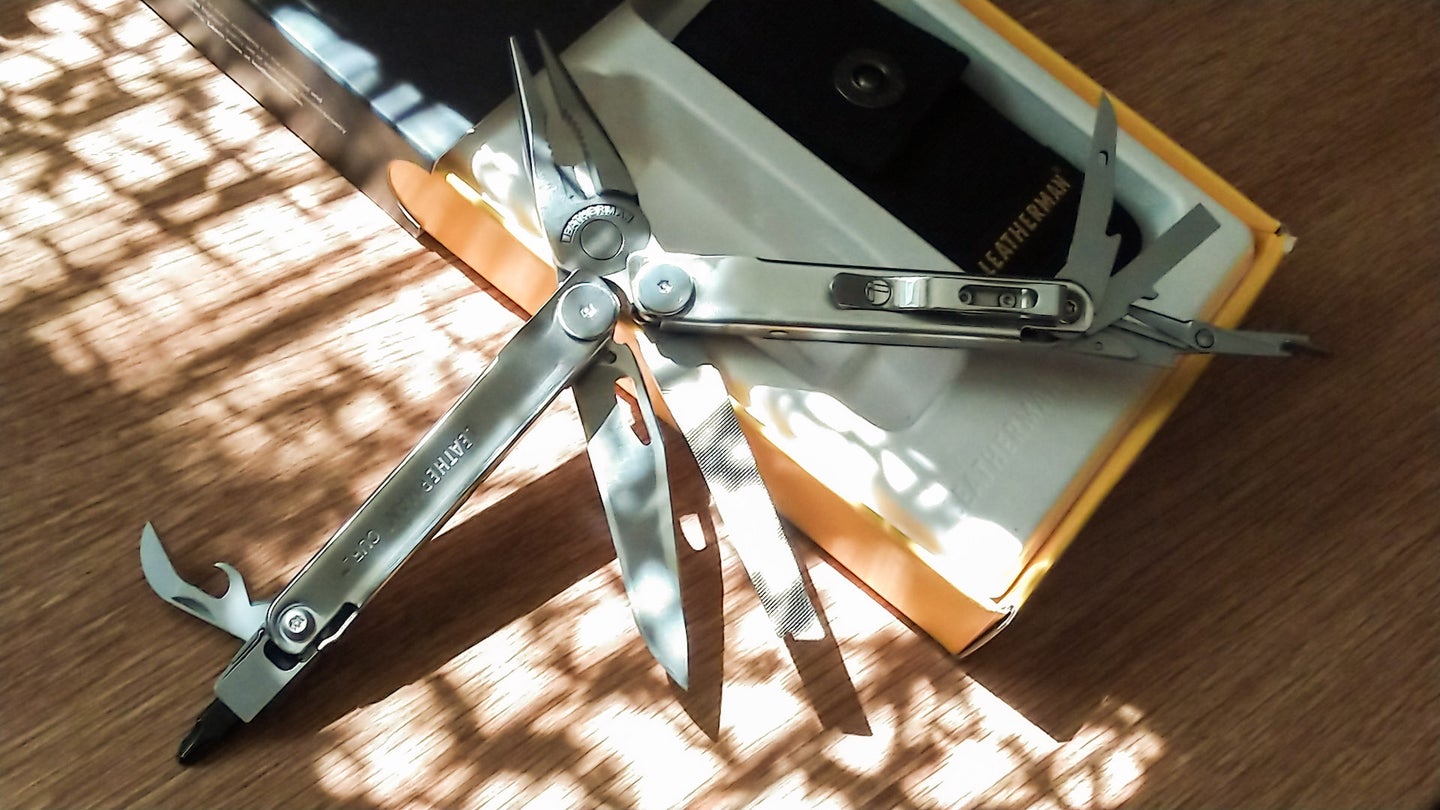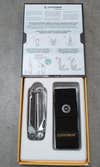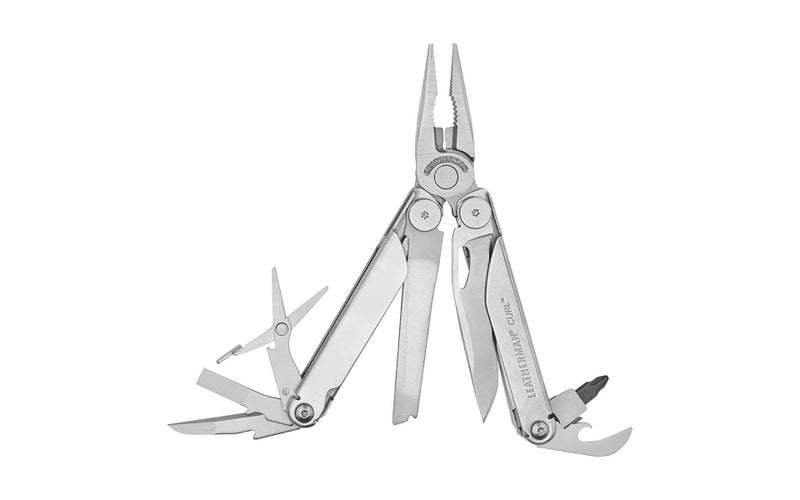Review: the Leatherman Curl is the next evolution in EDC multitools
The Leatherman Curl rides the Wave of its predecessor.

We may earn revenue from the products available on this page and participate in affiliate programs.
Leatherman is, without a doubt, one of the biggest, recognizable names in the multitool industry, commanding a solid section of the market. Named after their founder, Tim Leatherman, the company started out with the introduction of the Pocket Survival Tool (PST) in 1983, designed as a versatile, portable, multiple-function hand tool that could easily fit in your pocket or a pouch on your belt. More USA-made designs soon followed, and in 2007, Tim Leatherman was inducted into the Blade magazine Cutlery Hall of Fame.
One of my earliest memories of Leatherman was receiving a well-loved leather pouch from my uncle, and wondering what the name tooled into it meant. Over the years, I’ve sharpened, oiled, and often cleaned the rust off of old Leathermans, yet I’ve never owned one. I always wanted to have one, so when I was given the chance to review their newest model, I naturally jumped at the chance.
Designed as a lighter, slimmer, and more compact evolution of the Leatherman Wave, the brand-new Leatherman Curl is just slightly larger than the Leatherman Rev and was designed for everyday carry. It’s a budget-tier multitool, coming in at a little under $100, and made from more economical materials than the others in Leatherman’s inventory. The company accomplished this weight and size reduction by removing the saw and serrated blades and changing it to a smoother exterior, attempting to design a perfect everyday carry tool. Here’s why it may end up the next multitool in your arsenal.
Weight: 7.5 ozrnrnMaterial: 420HC stainless steelrnrnTools: Needlenose pliers, regular pliers, hard-wire cutters, wire cutters, wire stripper, knife, large bit driver, spring-action scissors, diamond-coated file, can opener, bottle opener, awl with thread loop, ruler, wood/metal file, medium screwdriver
Unboxing
I’m just going to come out and say it: Leatherman packaging gives off strong Russian matryoshka doll vibes. The Curl arrived in a small cardboard shipping box, which upon opening, contained a slightly smaller box that was a near-perfect fit to the inside of the shipping box — no wasted packing material in sight. Upon sliding that box open and lifting the warranty/instructional cardboard pamphlet out of the way, I was greeted by similarly spartan packing on the inside, with the brushed stainless steel multitool and its corresponding black nylon sheath neatly nestled into a molded cardboard insert. Suffice it to say that Leatherman gets full marks for minimalistic, environmentally-friendly packaging.

The Curl’s pouch is nothing to write home about exactly — it’s black, made from nylon, and has ‘Leatherman’ emblazoned across the front in big, friendly yellow letters. It has a solitary belt loop on the back, and a large metal snap marked ‘Leatherman’ on the front to secure the flap. The sides of the sheath are elastic, and as such hold the multitool very solidly in place when holstered, with around 3/8 inch of clearance between the Curl and the flap.
The Leatherman Curl itself is four inches long when closed, and made from stainless steel with a smooth satin finish. My eyes immediately jumped to the blade, comparing it to the Leatherman Rev that’s currently sitting on my workbench covered in rust. Both are made from 420HC steel, both are opened via an aperture in the blade, and both are enabled with a linerlock to lock it securely in the open position when in use.
That’s about where the similarities end, however. The Curl is almost half an inch longer with a blade length of just under three inches, providing a much better blade-to-handle ratio. The thumb hole is notably larger, and is much closer to the pivot, greatly increasing the ease of opening with your right hand. The action is smooth, but not drop-shut, which is exactly what I’d expect on a multitool. The detent ball is stamped into the leaf spring of the linerlock, as opposed to having an actual metal or ceramic ball press-fit in. The edge is relatively symmetrical, with a very slight recurve right behind the belly of the blade, and is properly apexed. Both the blade and the file on the opposing handle are running on phosphor-bronze washers, and all of the pivots have security Torx screws, indicating a preference for Curl owners to not disassemble their multitool. This is disappointing for someone like me who enjoys disassembling, cleaning, and tinkering, but understandable from a warranty perspective with a product that has 15 tools and miscellaneous hardware.
Speaking of those other tools: The file was a pleasant surprise, as it’s dual-sided, with a traditional cross-hatched wood file on one side, and a diamond matrix on the other side for metal and other hard materials. It’s secured with a similar linerlock as the one for the blade. Once you fully open the pliers, the Curl comes out to around 6.25 inches in length, and you can access the interior tools: an awl with thread loop, a quick-swap screwdriver that comes with a one dual-sided bit, a large flathead screwdriver, a bottle opener with Wire Stripper, and lastly a small set of scissors. The exchangeable-bit screwdriver is a nice touch, and has a simple spring detent to retain the bit. Bit expansion packs can be purchased separately from Leatherman, should you need more than a simple flat or Phillips-head driver. The spring-loaded scissors are better made than what I’ve seen on most other multitools and Swiss Army knife look-alikes, with a strong spring, sharp blades, and a small platform for your thumb. Most importantly, the pivot isn’t loose, and the blades are curved slightly toward each other, ensuring that the edges will remain in contact the entire length of the cut. The needle nose pliers feature a set of wire cutters, with the area closest to the pivot designed for harder wire — a well-thought-out feature, but it would have been nice to have had replaceable wire cutter inserts like some of Leatherman’s other models.
The body of the Curl is marked for use as a seven-inch long ruler, with one handle marked in centimeters, and the other handle in freedom units. There’s a stainless steel deep-carry pocket clip on the opposite side of the file handle, which sets the blade up for traditional tip-up carry on your right side. At around 1.24 inches wide, and just over half an inch thick, the 7.5-ounce Leatherman Curl disappears surprisingly well into your pocket, provided you’re used to carrying medium-sized pocket knives. The clip is secured in place with two standard T6 Torx screws, indicating that the clip is designed to be removed, should you prefer to carry it in the nylon pouch instead of your pocket.

How we tested the Leatherman Curl
As usual, I started off by checking to see that the blade’s edge was properly apexed and free of any nicks, burrs, or other edge deformation. The Curl was a hair-popping success in the first test, cleanly shaving the hair off my arm. The second test was to see how well it sliced paper; a fully apexed knife should be able to pass this test easily, as long as it doesn’t have a rough edge or edge deformation. Unfortunately, the Curl performed poorly on this test, frequently ripping paper throughout the entire length of the edge. Running the tip of my fingernail along the apex quickly revealed that it had a very toothy edge, due to the blade being sharpened at a lower, rougher grit. For some materials like fishing line, a toothier edge can actually cut better, as the micro-serrations will bite into the material instead of sliding off.
From there, I moved on to the edge retention test: seeing how much the knife can cut through various mediums. Once again, I used 550 paracord, and it didn’t take long before I started to get frustrated. I was anticipating dulling at around 50 cuts, but it actually started slicing through the paper smoother than before, as if the paracord had polished or stropped the edge. One hundred cuts — 150 — it kept slicing through the paper with progressively more and more ease. Finally, at a ludicrous 210 cuts, I started to see little specks of light reflecting on the apex where it was finally starting to dull, so I moved on to testing the edge geometry. I cut five slices off a Fuji apple; thinner blades like Spyderco’s full flat-ground Para Military 2 will typically be able to slice through easily, without causing any cracks in the apple slice. The Curl did poorly on this test as well, with four out of the five slices having large cracks in them. The blade didn’t cut smoothly through the apple at all, and I accidentally slammed the edge into my wooden cutting board, which immediately rolled the edge. The edge rolling over wasn’t a huge surprise, as 420HC is a softer budget steel.

At this point, I decided I should probably test some of the other tools, so I decided to see just how good the diamond matrix was on the dual-sided file. I happened to have an old axe head lying around that needed the edge completely reprofiled, so I pulled the file out and went to town. After a few hours of hand-filing spread over the weekend, I finally stopped to inspect the file. It appeared to have held up well, despite the excessive use. If I had to guess, I’d say that it was likely around 600 grit, though it might be a little lower than that.

The scissors cut paper and thread cleanly and easily, and over a week of using the Curl as my everyday carry, I found that it had a much more compact form factor than the medium-sized folders I’m used to carrying, and I frequently forgot that it was even clipped to my pocket. The last thing I did was put a new 20-degree edge on the blade and add a sharpening choil. Suffice it to say that the steel was very easy to work, as it took less than a minute to add the choil, and around 10 minutes to reprofile the edge on my Lansky system and strop the edge.
What we like about the Leatherman Curl
Overall, I loved the simple, slab-sided aesthetics of the stainless steel body, as it seemed to have fewer crevices and areas where dirt and rust could collect than the Rev. An added benefit to the plain design is that if the Curl does start to develop surface rust, it should be very easy to scrub it off with some steel wool. The thumbhole was an excellent idea, as it isn’t likely to snag on whatever material you’re cutting due to being lower profile than thumb studs, is easier to manipulate if you’re wearing gloves (or just have big hands), and it also helps to slightly reduce the weight. The location of the thumbhole was optimal, and it was nice to see that the edge was visibly pretty symmetrical and completely apexed. Sharpening the 420HC steel blade was a breeze, and thanks to the phosphor-bronze washers, thumbhole, and linerlock, opening and closing the knife with one hand couldn’t have been much easier. It was awesome to see the upgrade over older models to a dual-sided file, and the properly tuned scissors were just as much of a shock. The deep-carry stainless steel pocket clip was well implemented, and had just enough tension to hold the multitool securely in my pocket without any risk of it falling out, while still being easy to extract should I need its services.
What we don’t like about the Leatherman Curl
As much as I like this multitool, the Leatherman Curl has some serious issues. The knife had serious blade-play, where the blade could move both vertically and horizontally when it should have been locked solidly in place, and I couldn’t attempt to remedy it as I didn’t have any of the specialty bits on hand for the security Torx pivots. To top it off, the pivot holes aren’t keyed, which means that the pivot can rotate freely, requiring you to hold the pivot still with one security Torx bit, while loosening it with a second one. The thumbhole had a noticeable burr on the bottom, in addition to some rough machining on the top that made it a little unpleasant to open.

While the edge was decent overall, and certainly would be a good working edge, it was toothier than I would have liked, and didn’t have a very good transition into the ricasso — ideally, it should have come with a sharpening choil in that location. While 420HC was extremely easy to sharpen, it got damaged just as easily, and it would have been nice to see a more durable modern steel like 154cm on this model instead.
Furthermore, the Curl isn’t very welcoming if you’re a southpaw, due to the placement of the blade on the right side of its respective handle, and the pocket clip having only one location, which limits you to right-side, tip-up carry. Yes, you can clip it to your left pocket, but the blade would be oriented towards the front of your pocket with the tip up, which is a potential safety hazard. While the nylon pouch seemed to be well-made overall, it isn’t MOLLE-compatible, which limits use of that pouch to normal everyday carry use. Similarly, the lack of any sort of protective coating also limits how viable the Curl would be in a field environment, as you’d have to keep it clean and oiled to prevent rust from forming on the bare steel. Stainless steel isn’t named that because it doesn’t rust — it’s called that because it stains less than carbon steel.
Verdict
While it’s disappointing that it’s not MOLLE-compatible and doesn’t come with any sort of protective coating, Leatherman specifically designed the Curl for EDC, not field use. Thanks to the compact, slim design and deep-carry pocket clip, the Leatherman Curl is a fantastic option for everyday use at home, work, or around town, and you’ll be surprised just how often you’ll find yourself pulling it out to open a package, adjust a screw, or pry something loose. It’s extremely intuitive to use and is a well thought-out design, including a lot of design features that show Leatherman is still keeping up with the times, and hasn’t stopped innovating. I assume that the blade-play and poorly machined thumbhole found on mine aren’t commonplace, but should you have any issues down the road, you’re covered by Leatherman’s 25-year limited warranty, ensuring you years of enjoyment.

FAQs about the Leatherman Curl
More questions? Here’s Task & Purpose’s additional brief.
Q. How much does the Leatherman Curl cost?
A. The Leatherman Curl’s MSRP is $79.95 on Amazon.
Q. What is 420HC steel?
A. 420HC is a low-end stainless steel that’s used extensively by Buck Knives, Leatherman, and other companies. HC stands for high carbon, which means the steel can reach higher levels of hardness than standard 420 steel. It’s similar to AUS-6 and 5Cr15MoV Steel, and is used due to its low cost, easy machinability, corrosion resistance, and toughness. It’s typically heat-treated to 55HRC, but can max out at around 58HRC with a quality heat treat.
Q. What is a ricasso?
A. A ricasso is the unsharpened area of a blade, right between where the primary grind ends and the handle begins. There are a few reasons for the existence of a ricasso: It can be a purely aesthetic choice, a preventative measure to a high-stress area in the blade, a necessary feature for the locking mechanism, or to allow you to grip higher on the blade for increased control and torque.
Q. What is a linerlock?
A. The linerlock is a locking mechanism typically made of titanium or steel. The knife’s liner is cut so that a portion of it forms a leaf spring, commonly referred to as a lock bar, that butts up against the tang of the blade to lock the blade open. Due to the angled locking surface on the tang of the blade, the lock self-adjusts in response to wear. The linerlock concept originated in the late 1800s and was patented in 1906, but the modern version of the linerlock didn’t come about until the 1980s, thanks to the improvements made to the design by custom knifemaker Michael Walker. This included the addition of a heat-treated stop pin to add stability to the blade in the open position, and a detent ball to secure the blade in the closed position. There have been other variations and evolutions of the linerlock, most notably the Reeve Integral Lock (RIL), more commonly known as the framelock, and the Spyderco compression lock.
Q. Is the Leatherman Curl a balisong?
A. A balisong can be defined as a folding knife with two handles that divide and pivot around to expose the blade. I’m going to defer to Leatherman on this one, before I get in trouble with my opinion, which is — yes. Yes, it is. Or at least, it’s the plier-equivalent of a balisong. A plier-song, perhaps?
Got questions? Comment below & talk with T&P’s editors
We’re here to be expert operators in everything How-To related. Use us, compliment us, tell us we’ve gone full FUBAR. Comment below and let’s talk! You can also shout at us on Twitter or Instagram.
Our gear section
Josiah Johnston is an active duty Marine stationed at Camp Pendleton, originally from the Eastern Panhandle of West Virginia. He’s dabbled in blacksmithing, martial arts, competitive shooting, and is a self-described knife nerd.

